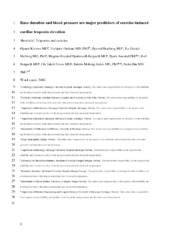| dc.contributor.author | Kleiven, Øyunn | en_US |
| dc.contributor.author | Omland, Torbjørn | en_US |
| dc.contributor.author | Skadberg, Øyvind | en_US |
| dc.contributor.author | Melberg, Tor Harald | en_US |
| dc.contributor.author | Bjørkavoll-Bergseth, Magnus | en_US |
| dc.contributor.author | Auestad, Bjørn Henrik | en_US |
| dc.contributor.author | Bergseth, Rolf | en_US |
| dc.contributor.author | Greve, Ole Jacob | en_US |
| dc.contributor.author | Aakre, Kristin Moberg | en_US |
| dc.contributor.author | Ørn, Stein | en_US |
| dc.date.accessioned | 2020-05-07T11:16:10Z | |
| dc.date.available | 2020-05-07T11:16:10Z | |
| dc.date.issued | 2019 | |
| dc.Published | Kleiven Ø, Omland T, Skadberg Ø, Melberg T, Bjørkavoll-Bergseth M, Auestad BH, Bergseth R, Greve OJ, Aakre A, Ørn S. Race duration and blood pressure are major predictors of exercise-induced cardiac troponin elevation. International Journal of Cardiology. 2019;283:1-8 | eng |
| dc.identifier.issn | 0167-5273 | |
| dc.identifier.issn | 1874-1754 | |
| dc.identifier.uri | https://hdl.handle.net/1956/22123 | |
| dc.description.abstract | Background: The underlying mechanisms of the exercise-induced increase in cardiac troponins (cTn) are poorly understood. The aim of this study was to identify independent determinants of exercise-induced cTn increase in a large cohort of healthy recreational athletes. Methods: A total of 1002 recreational cyclists without known cardiovascular disease or medication, participating in a 91-km mountain bike race were included. Median age was 47 years and 78% were males. Blood samples were obtained 24 h prior to, and 3 and 24 h after the race. Results: Cardiac TnI concentrations increased markedly from baseline [1.9 (1.6–3.0) ng/L] to 3 h after the race [52.1 (32.4–91.8) ng/L], declining at 24 h after the race [9.9 (6.0–20.0) ng/L]. Similarly, cTnT increased from baseline [3.0 (3.0–4.2) ng/L] to 3 h after the race [35.6 (24.4–54.4) ng/L], followed by a decline at 24 h after the race [10.0 (6.9–15.6) ng/L]. The 99th percentile was exceeded at 3 h after the race in 84% (n = 842) of subjects using the cTnI assay and in 92% (n = 925) of study subjects using the cTnT assay. Shorter race duration and higher systolic blood pressure (SBP) at baseline were highly significant (p < 0.001) independent predictors of exercise-induced cTn increase both in bivariate and multivariable analysis. The age, gender, body mass index, training experience and cardiovascular risk of participants were found to be less consistent predictors. Conclusion: Systolic blood pressure and race duration were consistent predictors of the exercise-induced cTn increase. These variables likely reflect important mechanisms involved in the exercise-induced cTn elevation. | en_US |
| dc.language.iso | eng | eng |
| dc.publisher | Elsevier | eng |
| dc.rights | Attribution-NonCommercial-NoDerivs CC BY-NC-ND | eng |
| dc.rights.uri | http://creativecommons.org/licenses/by-nc-nd/4.0/ | eng |
| dc.title | Race duration and blood pressure are major predictors of exercise-induced cardiac troponin elevation | en_US |
| dc.type | Peer reviewed | |
| dc.type | Journal article | |
| dc.date.updated | 2019-12-09T08:22:22Z | |
| dc.description.version | acceptedVersion | en_US |
| dc.rights.holder | Copyright 2019 Elsevier | |
| dc.identifier.doi | https://doi.org/10.1016/j.ijcard.2019.02.044 | |
| dc.identifier.cristin | 1702250 | |
| dc.source.journal | International Journal of Cardiology | |

